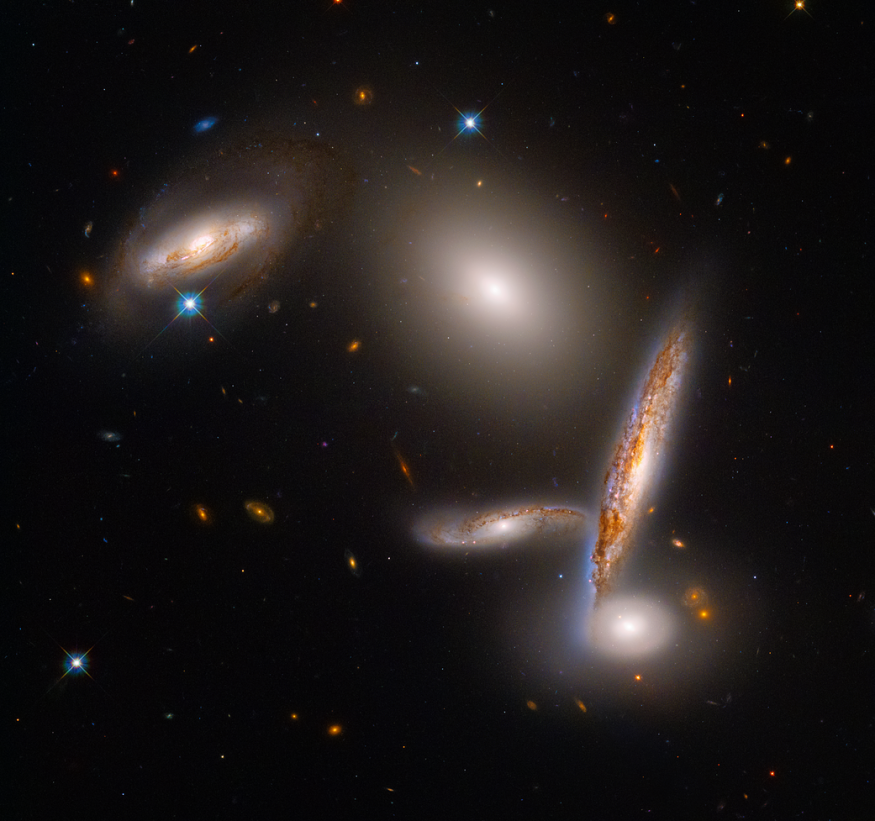NASA has released a Hubble image depicting a pair of "galactic wings" and five galaxies on the verge of colliding.
Since its debut in 1990, the Hubble Space Telescope has taken some of the most breathtaking images of the universe. Smithsonian Magazine said the optical instrument had captured images of large planets like Jupiter and Saturn and dream-like nebulas and other objects, allowing scientists to make incredible discoveries about the cosmos.
NASA Hubble Space Telescope Captures Galactic Wings
According to the European Space Agency, the galactic wings are part of the VV689 system, also known as the Angel Wing, which can be seen in the night sky in the constellation Leo. The distinctive wing-like appearance results from a catastrophic collision between two galaxies that have been merging for billions of years.
"Unlike chance alignments of galaxies, which only appear to overlap when viewed from our vantage point on Earth, the two galaxies in VV-689 are in the midst of a collision," NASA said.
The item resembles a pair of wings, as shown below. The wings are connected in the middle, fan out towards the top and bottom, and have a realistic symmetry.

Screen Rant said colliding galaxies often occur across the cosmos, though their appearance varies greatly. The collision of these two galaxies gives them a symmetrical and wing-like form, earning them the official designation of 'Angel Wing.'
As part of NASA's Galaxy Zoo project, Space.com said Hubble was used to uncover "Zoo Gems," which led to the discovery of the Angel Wing galaxy. Anyone may use Galaxy Zoo to look at various Hubble observations and vote on which ones should be researched further.
ALSO READ : NASA Hubble Space Telescope's New Discovery Could Be the "Missing Link" to Universe's Origins?
While the VV689 system's two galaxies are merging, Live Science said other views might be misleading.
In 2012, Hubble caught an image of what seemed to be two overlapping galaxies, dubbed NGC 3314, that appeared to be colliding. According to ESA, it was just a matter of perspective in that circumstance.
Many galaxy collisions are unavoidable, and they have been in the works for billions of years. Scientists can anticipate if and when galaxies collide by watching how they move relative to each other. Astronomers have estimated that the Milky Way will collide with our neighboring galaxy, Andromeda, in roughly 5 billion years.
Telescope Finds 5 Galaxies About To Collide
Meanwhile, NASA published a photograph of five galaxies dubbed The Hickson Compact Group (HCG) 40 to celebrate the telescope's 35th anniversary.
The group is crammed into an area less than twice the Milky Way's star disk size. Experts believe the quintet is merging into a single gigantic elliptical galaxy. The merger will take a billion years, and the image will allow scientists to analyze galaxy development, Space.com reported.

According to Science Alert, the cluster has three spiral-shaped galaxies ringed by orange dust clouds, a lens-like galaxy on the lower right, and an elliptical galaxy towards the top, all engaged in a compact gravitational dance.
While tight clusters of galaxies are not uncommon, they are most commonly seen near the center of bigger galaxy clusters. On the other hand, HCG is located in the constellation Hydra and is exceptionally isolated from everything else, making it an exciting topic for research, according to a statement.
The Hubble Space Telescope has taken 1.5 million photographs of 50,000 cosmic objects. The photographs are available for public viewing at the Mikulski Archive for Space Telescopes at the Space Telescope Institute in Baltimore, Maryland, and on NASA's Hubble Site.
RELATED ARTICLE : Hubble Space Telescope Captures Stunning Image of Unique Group of Galaxies in Its 32nd Anniversary
Check out more news and information on Space in Science Times.
© 2026 ScienceTimes.com All rights reserved. Do not reproduce without permission. The window to the world of Science Times.












